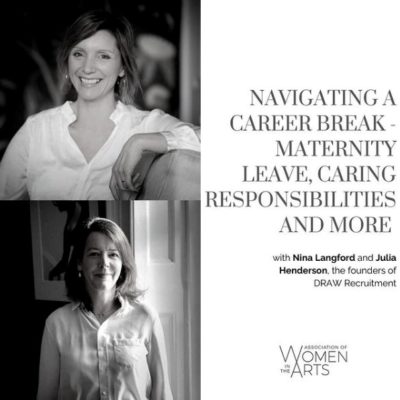As part of their latest talk for AWITA this week, our Directors here at DRAW – Nina and Julia, discussed returning to work. Here we will focus on returning to work after parental leave.
When Julia and Nina first met, one of their common threads was that they had both recently returned to work after a career break for maternity leave.
“In my case the end of my maternity leave felt like a battle with time as I wished for it to slow down (please stop growing up so quickly!) and speed up (only one more hour until my hubby is home!) all at once. Like most life transitions, returning to work was rife with mixed emotions.”
Julia
Of course this year has seen many more people taking enforced career breaks be that long period of furlough leave, or a period of unemployment. Whatever the reason for a career break there isn’t a manual for how to return to the workplace. Returning to work can feel overwhelming, stressful and exciting all at once. For those on maternity / paternity leave there is the conflict of leaving your baby vs wanting to go back to work, which is a constant push and pull.
Taking maternity leave can mean that you are taking a few years out of your career – depending on how many children you have and how long your mat leave is, so it’s important that you find ways to keep your advancement going as well as spending quality with the new addition!
Here are a few tips on making the transition back to work:
– Try to stay involved within the business and keep abreast of what is going on. Have a conversation with your manager about wanting to stay involved. If your boss appears less than supportive of your development or wishes throughout pregnancy and beyond, it might be down to a lack of training or fear of saying the wrong thing. In that case, the more preparation you can do to lead your manager, the more comfortable you’ll both be when it comes to working together on a plan of action.
Be strategic about how your use your keeping in touch days. Employees can work up to 10 days during their maternity or adoption leave. These days are called ‘keeping in touch days’. These are optional – both the employee and employer need to agree to them.
It’s advisable to stagger these KIT days towards the end so that anything that comes up in these meetings are more likely to be relevant to you.
– Take informal opportunities to network outside your KIT days. Formal meetings aside, you can learn as much about what’s going on at the company by popping in for a team lunch, a leaving do or even your work Christmas party. In those situations, you have the added benefit of re-establishing your connections with wider peers and senior management, so that when you see them again on a more formal basis, less time has elapsed since you last spoke. Ask colleagues to keep you in the loop about any such opportunities, and by staying socially visible, you will stay in people’s minds.
– As your back to work dates rolls around, get into a positive mind-set about returning. A lot of parents feel fearful about leaving their babies or new child and returning to work, and if you spend most of your time with other parenting friends, there’s a real danger that group mentality takes over and you end up dreading the day when you have to put your baby or child into childcare and head back to the office.
Spend time focusing on the positives of restarting your role, which will hopefully make you feel mentally stimulated again in a way.
If you’re struggling, reach out to an empathetic person from your HR or learning and development team who can coach you gradually back into the workplace.
– Recognise what you are taking back to the workplace with you. A lot of parents suffer a bout of low confidence as they head back to work. Think about the ways parenthood is going to make you an even better employee. You will have faced multiple challenges and had to find new ways of overcoming these challenges, which will hopefully make you stronger, more resilient (having a child really puts things into perspective!) and much better equipped to deal with situations.
– Plan your first few weeks very carefully.
However good you feel about returning to work, that first time you drop your child off at childcare is absolutely heart wrenching. It helps to stagger your child’s induction into nursery, starting with a few hours here and there from around two weeks before your return date, and gradually building up to a whole day. This will hopefully help ease you both into your new routine before your actual start date.
Also, try to keep life simple and relatively plan free those first few weeks as you’ll have enough to think about and get your head around!
– Mid parental leave you decide that you no longer want to return to work full time and would prefer part-time or flexi hours.
By law, you have the right to make a flexible working request if:
- you’ve worked for your employer for at least 26 weeks
- you’re legally classed as an employee
- you’ve not made any other flexible working request in the last 12 months
If you have the right to request, your employer must:
- look at your request fairly
- make a decision within a maximum of 3 months
- Some employers will allow you to make a request even if you do not have the legal right – check your workplace’s policy.
We are going to follow on from this post with advice for employers when navigating supporting employee’s with parental leave.
Notes from DRAW · 30.05.2021





